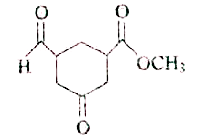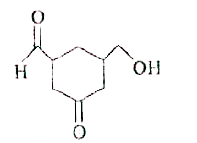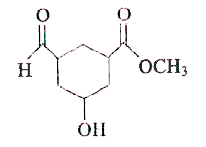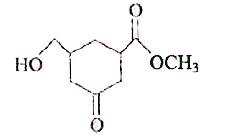Find the product when Phenyl acetylene reacts with dil. H2SO4 in presence of HgSO4




The correct Answer is:A
To find the product when phenylacetylene reacts with dilute sulfuric acid in the presence of HgSO₄, we can follow these steps:
1. Identify the Reactants:
- The reactants are phenylacetylene (C₆H₅C≡C-H) and dilute sulfuric acid (H₂SO₄) in the presence of mercuric sulfate (HgSO₄).
2. Understand the Reaction Type:
- This reaction is a hydration reaction, where water is added across the triple bond of phenylacetylene. The presence of HgSO₄ acts as a catalyst.
3. Markovnikov's Rule:
- According to Markovnikov's rule, when HX (where X is a nucleophile) is added to an alkene or alkyne, the more substituted carbon atom receives the nucleophile. In this case, the H⁺ from the acid will add to the less substituted carbon of the alkyne.
4. Formation of Carbocation:
- The triple bond in phenylacetylene will convert to a double bond after the addition of H⁺, forming a carbocation intermediate. The structure of the intermediate will be:
- C₆H₅-C(=C⁺)-H
5. Nucleophilic Attack:
- Water (acting as a nucleophile) will attack the carbocation. The hydroxyl group (OH) will attach to the more substituted carbon, leading to the formation of an enol intermediate:
- C₆H₅-C(OH)=C-H
6. Tautomerization:
- Enols are generally less stable than their keto forms. Therefore, the enol will undergo tautomerization to form the more stable keto form. In this case, the enol will convert to acetophenone (C₆H₅-C(=O)-CH₃):
- C₆H₅-C(=O)-CH₃
7. Final Product:
- The final product of the reaction is acetophenone.
Final Answer:
The product formed when phenylacetylene reacts with dilute H₂SO₄ in the presence of HgSO₄ is acetophenone (C₆H₅C(=O)CH₃).
- The reactants are phenylacetylene (C₆H₅C≡C-H) and dilute sulfuric acid (H₂SO₄) in the presence of mercuric sulfate (HgSO₄).
- This reaction is a hydration reaction, where water is added across the triple bond of phenylacetylene. The presence of HgSO₄ acts as a catalyst.
- According to Markovnikov's rule, when HX (where X is a nucleophile) is added to an alkene or alkyne, the more substituted carbon atom receives the nucleophile. In this case, the H⁺ from the acid will add to the less substituted carbon of the alkyne.
- The triple bond in phenylacetylene will convert to a double bond after the addition of H⁺, forming a carbocation intermediate. The structure of the intermediate will be:
- C₆H₅-C(=C⁺)-H
- Water (acting as a nucleophile) will attack the carbocation. The hydroxyl group (OH) will attach to the more substituted carbon, leading to the formation of an enol intermediate:
- C₆H₅-C(OH)=C-H
- Enols are generally less stable than their keto forms. Therefore, the enol will undergo tautomerization to form the more stable keto form. In this case, the enol will convert to acetophenone (C₆H₅-C(=O)-CH₃):
- C₆H₅-C(=O)-CH₃
- The final product of the reaction is acetophenone.
The product formed when phenylacetylene reacts with dilute H₂SO₄ in the presence of HgSO₄ is acetophenone (C₆H₅C(=O)CH₃).
Similar Questions
What is the product when acetylene reacts with HOCl
View SolutionA hydrocarbon (V.D. = 27) containing C = 88.88% decolourised KMnO4 solution and bromine water with evolution of HBr. It gave no precipitate with either ammoniacal silver nitrate or cuprous chloride solution. When treated with dil. H2SO4 in the presence of HgSO4, it gave methyl ethyl ketone. What is the hydrocarbon ?
View Solution
Knowledge Check
Find out the product when compound reacts with NaBH4:
 A
A B
B C
C D
D
Phenol reacts with conc. HNO3 in the presence of conc. H2SO4 to give :
Ameta nitrophenolBortho nitrophenolCortho and para nitrophenolDpicric acid
What happens when a sulphite reacts with dilute H2SO4 in presence of zinc ?
View SolutionA hydrocarbon (A) containing 90% carbon and having V.D. 20 reacts with dil. H2SO4 in the presence of H2SO4 to give (B). Compound (B) is reduced by LiAIH4 to (C) which on heating with H2SO4 gives (D). Compound (A) can be converted into (D) directly by hydrogenation in the presence of deactivated palladium-calcium carbonate catalyst. Identity the compounds (A) to (D) and explain the reactions involved.
View SolutionAccount for the product formed when phenyl ethyl ether reacts with HI.
View SolutionAn alcohol A, when heated with conc. H2SO4 gives an alkene B. When B is bubbled through bromine water and the product obtained is dehydrohalogenated with exccess of sodamide, a new compound C is obtained. The compound C gives D when treated with warm dilute H2SO4 in the presence of HgSO4. D can also be obtained either byh oxidising A with KMnO4 or form acetic acid through its calcium salt. Identify A, B, C, and D.
View SolutionProduct formed when PCl5 react with conc. H2SO4.
View SolutionWhen acetylene is passed through dil. H2SO4 in the presence of HgSO4, the compound formed is
View Solution
